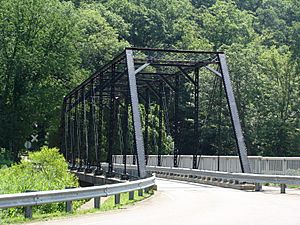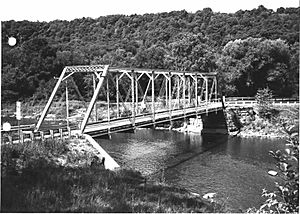Jersey Bridge (Cherrytree Township, Pennsylvania) facts for kids
Quick facts for kids Jersey Bridge |
|
|---|---|
 |
|
| Coordinates | 41°36′55″N 79°39′27″W / 41.61528°N 79.65750°W |
| Carries | SR 1011 |
| Crosses | Oil Creek |
| Locale | Venango, Pennsylvania, United States |
| Other name(s) | Bridge in Cherrytree Township |
| Maintained by | PennDOT |
| NBI # | 601011001014800 |
| Characteristics | |
| Total length | 42.7 m (140 ft) |
| Width | 10.1 m (33 ft) |
| History | |
| Constructed by | Morse Bridge Company |
| MPS | Highway Bridges Owned by the Commonwealth of Pennsylvania, Department of Transportation TR |
| NRHP reference No. | 88000809 |
| Added to NRHP | 22 June 1988 |
| Lua error in Module:Location_map at line 420: attempt to index field 'wikibase' (a nil value). | |
The Jersey Bridge is a special bridge that crosses Oil Creek in Cherrytree Township, Venango County, Pennsylvania in the U.S.. It's a type of bridge called a Pratt through truss bridge, which means it has a strong framework on its sides. This bridge helps connect the city of Titusville to important places like the Drake Well Museum and Oil Creek State Park. It was added to the National Register of Historic Places in 1988 because of its historical importance. Even though it looks old, parts of it were updated in 1998 to make it safer and stronger.
Contents
A Look Back: History of Jersey Bridge
The Jersey Bridge was first built a long time ago in 1882. A company called Morse Bridge Company constructed it. In 1979, the Pennsylvania Department of Transportation (PennDOT) put a weight limit on the bridge. This was because the bridge was getting old and needed repairs.
Why the Bridge Was Replaced
Because of its age, the bridge was listed on the National Register of Historic Places in 1988. This means it was recognized as an important historical structure. However, by 1997, PennDOT decided the bridge needed to be replaced. This was to make sure it was safe for everyone. It also allowed bigger vehicles, like tour buses, to reach the nearby Drake Well Museum.
How the Replacement Affected the Museum
Replacing the bridge was a big project. It was the only way to get to the Drake Well Museum by road. Because of the construction, the museum had to close for a few months in late 1997. But don't worry, it reopened in April 1998! An agreement was made with the Oil Creek and Titusville Railroad. This allowed tourists to take a train from Titusville directly to the museum. The newly updated Jersey Bridge officially reopened on May 27, 1998.
How the Bridge is Built
When the Jersey Bridge was rebuilt in 1998, engineers kept the original bridge's top part. This top part is called the superstructure. It's the visible framework that gives the bridge its shape. The original superstructure was a "pin-connected, Pratt through truss bridge." This means it used metal pins to connect its parts, forming a strong triangle pattern.
Modern Updates to the Bridge
Even though the old superstructure was kept, the actual bottom part of the bridge was updated. This bottom part, which holds the weight, is now a common girder bridge. A girder bridge uses strong beams to support the road. The bridge is still only one lane for cars. But now, it also has a special walkway for people. This walkway is on one side of the bridge, outside the main framework, making it safe for pedestrians.


